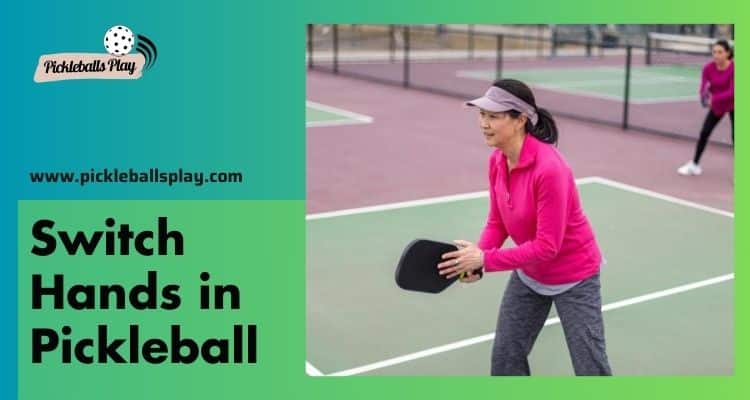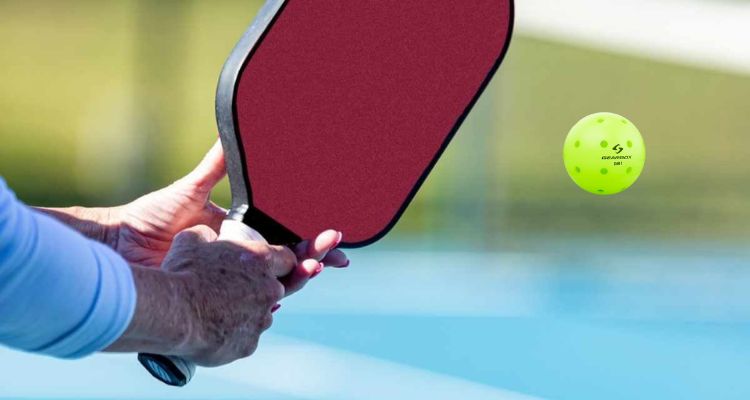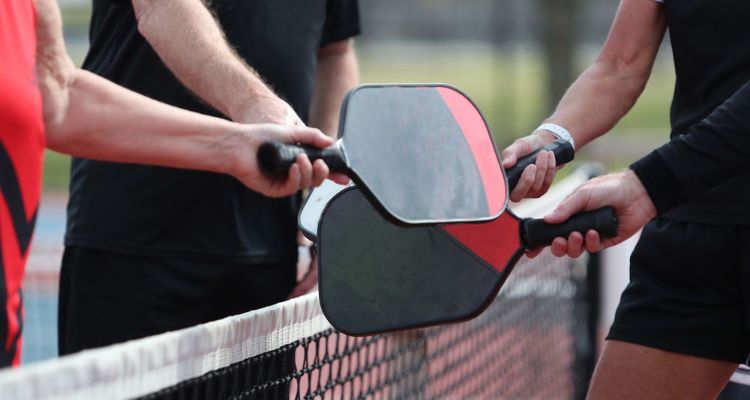Pickleball’s rise in popularity has players of all levels asking questions about the game’s rules and techniques. One common query is, “Is it ok to switch hands in pickleball?” Whether you’re a beginner reaching for a tricky shot or an advanced player looking to mix up your strategy, understanding the legality and practicality of switching hands can enhance your game.
Is Switching Hands Legal in Pickleball?
Yes, it’s perfectly legal to switch hands in pickleball! The USA Pickleball Official Rulebook, updated for 2025, explicitly states in Rule 11.B: “A paddle may be switched from hand to hand at any time.” This means you can transfer your paddle between your right and left hands during a rally, before a serve, or at any point in the game. There’s no restriction on when or how often you can switch, giving players full flexibility to adapt on the court.

Unlike some sports with strict equipment-handling rules, pickleball embraces this freedom. However, while it’s allowed, the real question is whether it’s a smart move for your gameplay. Let’s explore the pros, cons, and scenarios where switching hands makes sense.
Why Would You Switch Hands in Pickleball?
Switching hands isn’t just a flashy trick it can serve practical purposes. Here are the main reasons players consider it:
- Extended Reach: If a ball is wide on your non-dominant side, switching hands can help you reach it without relying on a weaker backhand.
- Injury Management: Players with a sore dominant arm or recovering from an injury might switch to keep playing comfortably.
- Surprise Factor: Changing hands can throw opponents off, disrupting their rhythm and expectations.
- Weak Backhand Compensation: For those with an inconsistent backhand, switching to hit a forehand with the other hand can feel more natural.
While these reasons sound appealing, switching hands isn’t a one-size-fits-all solution. Let’s weigh the advantages and disadvantages to see if it’s worth adding to your game.
Advantages of Switching Hands in Pickleball
Switching hands can give you an edge in specific situations. Here’s how:
1. Greater Court Coverage
Switching hands extends your reach, especially in singles play where you cover the entire court alone. For example, if you’re right-handed and a ball veers far to your left, switching to your left hand lets you hit a forehand instead of stretching for a backhand.
2. Stronger Shots
Many players find their forehand more powerful and controlled than their backhand. Switching hands allows you to use your forehand on both sides, potentially delivering harder, more accurate shots.
3. Opponent Confusion
A sudden hand switch can catch opponents off guard. They might expect a backhand spin or angle, only to face a forehand attack, giving you a split-second advantage in fast rallies.
4. Injury Workaround
If your dominant arm is fatigued or injured, switching hands can keep you in the game. Some players, like those with temporary shoulder issues, use this tactic to avoid sitting out.
| Greater Court Coverage | Extends reach for wide shots |
| Stronger Shots | Uses forehand power on both sides |
| Opponent Confusion | Disrupts opponent’s anticipation |
| Injury Workaround | Allows play despite dominant-arm discomfort |

Disadvantages of Switching Hands in Pickleball
While the benefits are enticing, switching hands comes with challenges that might outweigh them for many players. Here’s what to watch out for:
1. Slower Reaction Time
Pickleball is a fast-paced game, especially at the net during dink rallies or volley exchanges. Switching hands takes time even a fraction of a second can mean missing a shot or giving your opponent an easy point.
2. Reduced Consistency
Your non-dominant hand likely lacks the finesse and muscle memory of your dominant one. This can lead to mishits, weaker shots, or balls flying out of bounds, especially under pressure.
3. Coordination Challenges
Transferring the paddle smoothly requires practice. A fumbled switch could leave you paddle-less mid-rally, turning a clever move into an embarrassing mistake.
4. Partner Confusion in Doubles
In doubles, switching hands might confuse your partner, disrupting teamwork. If they expect you to cover a shot with your dominant hand, an unexpected switch could lead to a collision or missed opportunity.
| Slower Reaction Time | Delays response in fast exchanges |
| Reduced Consistency | Non-dominant hand lacks precision |
| Coordination Challenges | Risk of dropping paddle during switch |
| Partner Confusion | Disrupts doubles coordination |
When Should You Switch Hands in Pickleball?
Timing is everything. Switching hands works best in specific scenarios here’s when it’s most effective:
- Defensive Reach: When a ball is just out of reach on your weak side, and you can’t get there with footwork or a backhand, switching hands can save the point.
- Slow-Paced Moments: During a lob or a slower rally, you have time to switch without rushing, making it a safer option.
- Injury Necessity: If your dominant arm is compromised, switching becomes a practical way to stay competitive.
- Tactical Surprise: In a casual game or against predictable opponents, a well-timed switch can shake things up.
Avoid switching during rapid-fire volleys at the net or when you’re already in position to hit a solid backhand. The risk often outweighs the reward in these high-speed situations.
What Do the Pros Say About Switching Hands?
Professional pickleball players rarely switch hands during competitive play, and there’s a reason for that. Elite-level pickleball demands lightning-fast reflexes, and pros like Ben Johns and Anna Leigh Waters rely on strong backhands and precise footwork instead. However, some pros, like Rick Witsken and Wes Gabrielsen, occasionally switch hands for defensive reach or to mix up their game.
Witsken, a senior pro, has noted that switching hands is useful for players with limited mobility or when stretched wide on the court. Yet, he cautions against it in fast exchanges, emphasizing that a solid backhand is more reliable for most. Roughly 30-40% of pros switch hands situationally, but it’s not a core part of their strategy proof that it’s a niche tactic, not a game-changer.
How to Practice Switching Hands Effectively
If you’re sold on trying this technique, practice is key. Here’s how to get started:
- Start Slow: In a controlled setting, like a warm-up, practice passing the paddle between hands. Focus on a secure grip and smooth transfer.
- Drill Simple Shots: Hit forehands with your non-dominant hand against a wall or partner. Build confidence before taking it to a game.
- Simulate Game Scenarios: Have a friend hit wide shots to force a switch, mimicking real-match pressure.
- Use a Neutral Grip: A continental grip (like shaking hands with the paddle) makes switching easier without major adjustments.
Consistency comes with repetition. Don’t expect to nail it in a competitive match without putting in the reps first.
Alternatives to Switching Hands
Not sold on switching? You’ve got options to handle tricky shots without changing hands:
- Strengthen Your Backhand: Practice backhand drills to boost power and accuracy, reducing the need to switch.
- Two-Handed Backhand: Borrow from tennis use both hands for added stability and strength.
- Improve Footwork: Better positioning means you’re less likely to need an emergency switch.
These alternatives often provide more consistency and speed, especially for intermediate players looking to level up.

Is Switching Hands Right for You?
So, is it ok to switch hands in pickleball? It’s legal and can be effective in the right moments. But should you? That depends on your skill level, goals, and comfort. Beginners might find it risky, while advanced players could use it as a strategic wildcard. If you’re ambidextrous or recovering from an injury, it’s worth experimenting with. Otherwise, a strong backhand and solid footwork might serve you better.
Here’s a quick checklist to decide:
- Do you struggle with your backhand? (Yes = consider switching)
- Are you comfortable with your non-dominant hand? (Yes = easier to adapt)
- Do you play fast-paced games often? (No = safer to switch)
- Are you willing to practice? (Yes = more likely to succeed)
Conclusion: Paddle in Hand, Choice in Mind
Switching hands in pickleball is a legal, creative option that adds versatility to your game. It’s ok to do it, and in certain situations, like stretching for a wide shot or managing an injury, it can be a lifesaver. However, the fast pace of pickleball and the need for consistency mean it’s not for everyone. As of 2025, the rules support it, but the pros remind us it’s a tool, not a necessity. Practice, weigh the pros and cons, and decide what fits your style. Whether you stick to one hand or master the switch, the goal is the same: keep the ball flying and the points coming!




